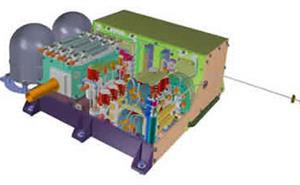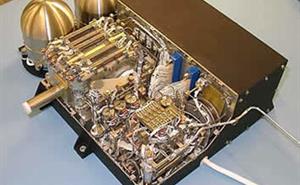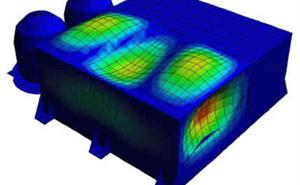The ability to quickly produce 3D-CAD models of design concepts is enormously useful during initial trade-off studies. Converting rough sketches and design ideas into preliminary models allows accommodation issues to be addressed and interfaces to be defined. From this point, key areas for study can be identified and the feasibility of designs assessed.
3D-CAD models can also be realised using rapid-prototyping techniques to improve the visualisation of complex 3D geometry or complex accommodation schemes. These techniques have been used to good effect on several projects. Alternative conventional mock-up techniques are also available within the division through the Precision Development Facility.
The production of an initial 3D-CAD model is also the first step in the design of structures to support the various subsystems. Finite Element Analysis (FEA) of these models is conducted using ANSYS (Classic and Workbench) to assess the stiffness and strength of designs. The results of these analyses are a key part of the feasibility trade-off studies discussed above.
Much of our work requires solutions to unique objectives which calls upon a creative and innovative approach.
Detailed design
 Once a concept has been selected for further study, the job of producing a detailed design begins. Often this requires the co-operation of several groups of people, working in a range of different technical disciplines.
Once a concept has been selected for further study, the job of producing a detailed design begins. Often this requires the co-operation of several groups of people, working in a range of different technical disciplines.
Our Mechanical Engineers and Designers are involved in all areas where mechanical components need to be produced. Our use of 3D-CAD Software (Pro-Engineer or Solid Edge) enables us to create flexible parametric mechanical designs that can be iterated quickly as the requirements from other subsystems develop.
Detailed finite element models (FEMs) are created using ANSYS or Pro-Mechanica to enable us to assess the structural stiffness and strength of our designs. Improvements to designs identified by this analysis can quickly be fed into the CAD model and assessed for practicality before proceeding with the design process in an iterative manner.
Our Mechanical Engineers and Designers are experienced in the use of Pro-Engineer and Solid Edge to produce detailed drawings of assemblies and components ready for manufacture. We also have the capability to convert drawings and models into a number of alternative common formats.
All design documentation is controlled under our ISO 9001 system and best practices such as ESA's European Co-operation for Space Standardisation (ECSS) are followed.
Mechanical development, assembly, integration and testing
 Our holistic approach to mechanical engineering does not stop with the production of manufacturing drawings. Members of the section are actively involved in all stages of the project lifecycle, including:
Our holistic approach to mechanical engineering does not stop with the production of manufacturing drawings. Members of the section are actively involved in all stages of the project lifecycle, including:
- the specification and procurement of components,
- hardware assembly and inspection,
- test specification and support,
- instrument delivery and integration.
Mechanical analysis
 The Mechanical Engineering Group uses ANSYS and Pro-Mechanica to analyse and improve the structural components of a design. To ensure our designs achieve structural requirements we utilise both static and dynamic simulations to model launch and operational environments.
The Mechanical Engineering Group uses ANSYS and Pro-Mechanica to analyse and improve the structural components of a design. To ensure our designs achieve structural requirements we utilise both static and dynamic simulations to model launch and operational environments.
We have also used the finite element technique to assess the distortion of structures due to thermo-mechanical interactions.
Images:
Conceptual Studies and Design: Conceptual design of Ptolemy instrument on board the Philae lander for ESA's Rosetta mission. Credit: STFC RAL Space
Detailed design: Detailed mechanical design of the Ptolemy in 3D-CAD Software. Credit: STFC RAL Space
Mechanical development, assembly, integration and testing: Mechanical assembly of the Ptolemy instrument. Credit: STFC RAL Space
Mechanical Analysis: Thermo-mechanical analysis of the finite element model of Ptolemy. Credit: STFC RAL Space
For more information please contact: RAL Space Enquiries
